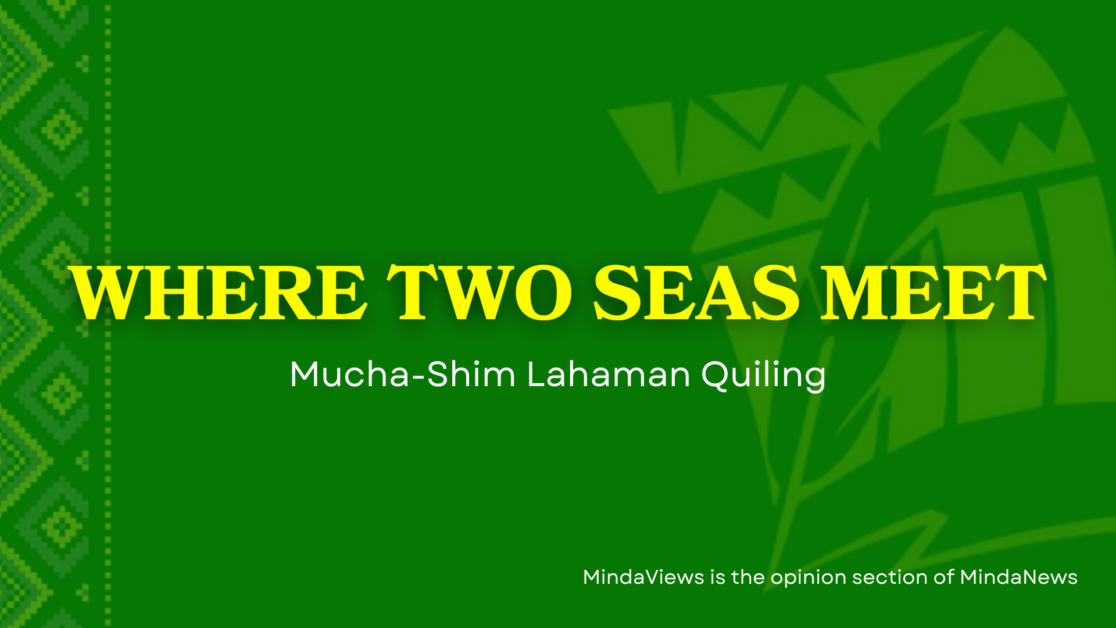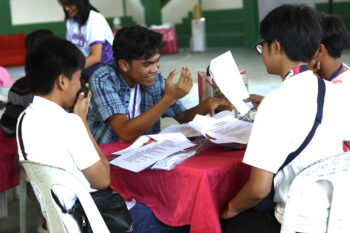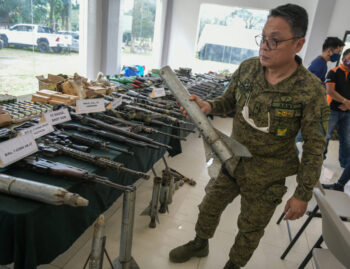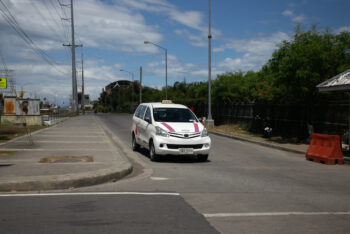
Panyam and Sindul. Hauled out from the kitchen of pelagic people of Sulu, what do these two delicacies have in common? Both are made out of rice, and both are ritual foods perennially present as signatures in the periodic observances of social and cultural events and businesses of religio-spiritual significance called Hinang (verb: paghinang) among land-based Sama, and Bowat (verb: pagbowat) among the Sama Dilaut communities.
Neither rice-planters nor maintaining a principally agricultural economy, but present-day Sama people in fact earn their income primarily from private commerce and public employment, and for a few, remains relying on fishing livelihoods. Nevertheless, coastal and island-dwelling communities of Sulu archipelago, have been consistently and continually summoning these two rice-based confectioneries as mandatory in dressing-up a complete dulang – or, to be culturally correct, say langkap (full) to be ritually satisfactory to bear the requirements of the indispensable symbolic role of food – rice, in this instance – in devotional practices preparatory to the fasting month of Ramadan.
Dulang is an assemblage of food in varieties of viands and dishes bundled with cooked or boiled rice and an accompanying beverage or drink arranged smorgasbord-wise in a tin or bronze round tray called talam. In contemporary times, a dulang langkap (complete and satisfactory dulang) would be a food bundle of from as few as three to as complicated as ten (10) or a dozen viands, vegetable dishes, and desserts or finger-foods (i.e. sweets) served in small dishes called tapak, in circular placement surround a mountain-shaped rice topped and bolstered on four sides with five medium-sized panyam.
The entire ritual process is called Hinang (literally, “event” or “business”). The food preparations and dulang assemblages of a Hinang done in the month of Sha’ban can be further classified – depending on the beneficiaries and intentions – as pag-hinang sarakka, pag-hinang pangadji-an, or pag-hinang botang-dulang. The pag-hinang sarakka is a dulang intended for gift or sarakka to individual living person/s who are held as stand-in or proxies in the effort to ask for Allah’s mercy and gain spiritual merit for the soul of a dear departed. It is in this sense that the dulang sarakka is also believed to be a spiritual food to nourish the ghosts of beloved in their ethereal resting places. The paghinang pangadji’an is a set of dulang that is brought to a langgal or masjid or a common ancestral residence for botang (literally, share) where every nuclear family of the clan come together in a communal prayer and to petition for blessings and health. The latter is also known as ‘botang-dulang’, literally meaning chipping-in for the general or group merits for the living. Again, Allah’s mercy and blessings is sought for through the intercession of the officiating imam, a male ritual leader.
Sampul. In all the dulang of hinang- pangadji’an and dulang-botang, the sampul or “rice mountain” is compulsorily of buwas kuning or turmeric-dyed rice cooked in coconut milk, and following the prescriptive measure of one ganta or 2.5 kilograms of rice cooked and rolled up into one large mountain shape as sampul. In recent time, it has become optional to send out a special dulang (consisting of the same assemblage of food bundle either as sarakka or botang-dulang) to the Lumah Mehe or Lumah Pag entanan (Ancestral Spirit-house), but done only on behalf of those among beloved departed and family members who had conscripted during their lifetime to be ag-entan or be a devotee of the Lumah Mehe.
After being prayed over, the blessed bundle of nourishment is called gimas or ‘prayed-over’ food. The sarakka can then be partaken of by the recipient and his or her household members, while the gimas of pangadji’an is returned to the family of household organizing the event (lumah bay maghinang) for the members to consume and share. A dulang intended as botang may be eaten and distributed among the jama’a (congregants) of a masjid or among the imam (male ritual heads) of a langgal after the duwa’a.
Panyam. This round serrated rice-cake whipped and cooked out from a combined batter of rice-flour, sweetener (either of molasses or gulah from palm sugar or cane or of brown milled sugar), and coconut milk is deep-fried in naturally extracted pure coconut oil. One national news article once went around the social media featuring panyam and misconstrued it as a “staple Muslim food.” Panyam is not a staple in Sulu, and there is no such thing as “Muslim food”. But this special cake is indispensable in every Hinang. The panyam crowns every mound of boiled rice – either of plain white (for sarakka) or stained turmeric-yellow (for pangadji’an) – called sampul, the centerpiece of the ceremonial dulang. If the Sama Yakan of Basilan are touted to be the best bangbang Ja-makers (Ja is another variation of rice-based fried confectionery but is not usually served in this kind of hinang), the Sama women of Simunul island in Tawi-Tawi claim to cook the best panyam.
The women of Laminusa and those in island-Sulu archipelago are one in their connoisseur appraisal that the virtue of each panyam is in the lantik lengget biring na – the graceful curl of a consistently spaced and deeply curved serration of the cake’s edges frilling a generously plump and well-rounded core – so beautiful and so good that it could be used panudjun malaikat – thrown as bait to lure discriminating angels into leaving their lofty abodes and fly down to bless your offertory food.
Inah si Ada (Ada’s mother) of Laminusa island, already a ritual-leader in her young 30’s, shyly described her beautiful panyam by crediting her alengnget biring panyam na to the manner of pagbuwang (dipping the batter in oil), that is: ‘Subay a hap ka titih ensellan maka sarang pasuh na.’ It is in the gentle tapping of a tempered oil to optimally let it lap the fringes of the dough. Taking a test-bite of her panyam’s full and plump center I was delighted to find the fringes crunchy while the core was chewy and juicy to the bite, to which remark of surprise she impishly smiled whispering her secret only for my ear: she slaps her dough with a big splash of condensed milk!
There is definitely a feminine aspect to every panyam in that as a lissome lady, her graceful curls and deeply curved frills combined with a full, plump, and firm center are the ultimate measures of a good ritual food. This perfect rice-cake comes out of the woman’s gentle grace in the tapping, beating, and turning of the batter after it is launched –binuwangan– into the boiling deep fry, even as she simultaneously deals with the hot oil and taming it to a sizzle without reducing the flame. She meticulously times it to be tempered enough that only an expert like her could bring batter and oil to come into a perfect alchemical finale.
Yet the panyam has its masculine lengget, too. The process of Pag-panyam is a display of how good sailors the Sama are as maritime people, men and women alike. The perfection of ritual panyam lies in the calculated way the Sama woman stirs the hot oil into a frothing sea-waves while in the same move maneuvering the batter into necessarily sequential order of launching, sailing, swerving and maneuvering, and to finally, lithely float a majestic boat of ritually-satisfactory and complete rice confectionery amid a storm of boiling sea, now, with her gentle coaxing, gradually calming down into a patient hiss. Such is a Panyam, as in any endeavor to be Langkap, it needs to be tamed and graduated to be full and complete.
Sindul has its own story, too. If the panyam is to court divine blessings through the intercession of the ghaib and malaikat (saints and angels), sindul is a food-medium of barakat exchange for a human to bless fellow human. Ingredients are basic powdered rice rolled with thin coconut milk into a dough and stripped into thin noodle-like strands or, thinning the dough enough to flow into droplets drowned into a gurgling coconut soup by tapping a specially holed sieve for the slosh to pass through and neatly drop into the pot in tear-shaped pearls. Mixed with red mongo beans or coarse grated corn, the porridge is cooked in thick coconut milk and lavishly sweetened with molasses or brown sugar and brought to a rolling boil until turned into a syrupy consistency. The preparation is common as breaking-of-fast (bukah or iftar) food neighborly shared during Ramadan (9th lunar Muslim month for fasting).
Tradition has it, not too surprisingly, that we share an old tale of the ‘religious’ significance and origins of the sindul with our Christianized Visayan neighbor’s tabirak or binignit famously served during the Holy Week of Lent that traces back to the Yemeni (hadrami) ancestors who reached us en route from the Minang people of Sumatera – tickling me and titillating a hint of truth to a wishful thought and ‘what ifs’ of possible common precolonial religious origins between us and our Visayan brethren before their conversion to the religion of Iberian conquistadores.
It was believed that during Ramadan as the season usually fell on a dry and postharvest month owing to it being the “hot season” and Muslim communities would find every jar, baul, sack cupboard, granary, and domestic storages already almost empty while planting and harvest season were still far to go. Neighborhood members would chip in grains, roots, and nuts they could find and bring them together for a communal cookout of what would turnout a big cauldron of potpourri of ingredients boiled for a long wait in sweet and sticky soup for everyone to be able to have contributed and shared. This tradition called pag-botang among the Sama was brought to our Sulu shores by the makdumin and awliyah (local saints), who came to bi-at (initiate) our foreparents about Islam. The tradition of magsindul during auspicious social and cultural occasions like taitih, maulud, puasa of Ramadan and extended to other life and death rituals still lingers and continues in islands of Sulu, like Laminusa, and in the hinterland guimba as well.
Yet old folks also surmise that the ritual significance of sindul is derived from the simple santan (sweetened cononut milk) that used to accompany the sampul kuning (turmeric-yellowed boiled rice shaped into mound) of paghinangan and pangadji’an rites. Santan has disappeared from the dulang of paghinang, only to be resurrected in the Sahoor predawn meal of fasting as a favorite dessert or breath sweetener, with coconut milk mixed with beaten egg and slowly boiled, sweetened, and infused with smashed overripe banana, jackfruit, durian or fruits in season that the other ethnics of Sulu, like the Tausug, has literally baptized in Sinug as sabaw maymuh (sweet soup).
In short, before it turned elaborate into a smorgasbord of status-signifier feast, the island folks of old had simpler dulang to prepare – for the rich and poor alike – the ritual food consisted only of two essentials: sampul and santan, respectively of rice and coconut.
In time, as the island’s economy prospered and going by the rate of rising social rank and economic status of the island residents, the capacity for travel and affordances of cosmopolitan lifestyle in the city brought in new innovations enabling the basic dulang – from its simple rice and coconut entree – it became an elaborate assemblage of rice with viands, not only of one kind, but of a dozen or more and the complexities as much as nigh impossibilities of mixes_and_matches that only the creative feminine heart and hand could conjure up.
In Laminusa island, my elder female relatives, Kakah Bening, a retired public nurse, and Kakah Santanina, a retired government employee, now in their senior years, have assumed their places as ritual leaders of my clan. For this Nisfu Sha’ban observance, they had come all the way from Zamboanga City to the island to officiate and manage the paghinang.
Carefully planning every detail of dishes, deciding on the matches and combinations of menu to make, and fussing over their presentation in the dulang, they had everything procured from the supermarket in the city, making sure that every ingredient would be available to whip up as many varieties of viands and dishes for the dulang langkap. A balanced assortment from all three groups of fish, chicken, or meat dishes, vegetables and fruits dishes, and the confectioneries is ensured. Finally they decided on an elaborate dulang almost approximating the laureate tray of a 10- or 12-course smorgasbord. In Kakah Bening and Kakah Nina’s estimates, the higher and better the economic status of the ritual leaders – and the ancestral ghosts to be “fed” – the more variations of viands both women must offer.
A not-too-delightful sign-of-times innovating this year’s paghinang, however, was most noticeably the nostalgic bowing out of the thermos of native coffee or hot cup of tea to be replaced by plastic bottled soda in single-sizes that have now become common choices for beverages to pair with the solid food. Almost ten years ago in 2016, I have noticed that among the Sama Tabawan the bottled soda were served inside the Lumah Maheya and in their dulang instead of hot native beverages, to which i calmed my heart and said a prayer of thanks that Laminusa still held on to the tradition of kahawa in their dulang. But the instant gratification in plastic culture has been infectious, soon to trail in the bandwagon of “instant” and “plastic” are the care-free conveniences of disposables: of paper plates and styrofoam food containers that have now become alternatives to the breakable and heavy glass and China dishes (i.e. tapak) that young women like Rizaliana and Inday are happier with, as these are lighter while saves them the trouble of retrieving and washing, and easier to head-carry, too, when negotiating the flimsy bamboo stilt bridges to the lumah ma dilaut (houses on stilts) to deliver the dulang to their beneficiaries.
To the Sama people, who practice the Islam kamatto’ahan or Islam of the old folk, the Hinang in the month of Sha’ban and the food offered as paghinangan and pagduwaa pangadji’an offertory are an important prelude to the fasting month of Ramadan. The paghinang and pagduwaa as a ritual of nourishing or “feeding” of the soul for the departed loved ones in their ethereal abodes is a symbolic giving of the paghinangan food as sarakka (thanksgiving charity). The recipients of sarakka are particularly chosen from among the miskin (poor), yatim (orphans), balu (widow/er), and among elder members of community. Old friends and close acquaintances of the dear departed are also potential receivers of sarakka.
This lunar year of 1445, in Laminusa island, the paghinang and pagduwaa pangadji’an were done on the last seven days of the month of Sha’ban where world Muslims also mark as the month of Nisfu – (falling on the 2-9th March 2024) for remembering the dead. Although days and even months may have been involved in its preparations, the actual Paghinang are held for two consecutive days on the pitu’ kamatayan or last seven days of the waning moon (of Sha’ban). The first day is devoted to the pagtapung (i.e. the ceremonial pounding of rice into flour). In the olden days, pagtapung was carried about together with paggulah, the ceremonial extraction of honey or molasses from sugarcane or palm sugar, and the pag-ensellan, the communal distillation of virgin coconut oil for cooking panyam and for lighting the tombs. But with the scarcity of sugarcane, women have done without the encumbrances of sugaring the canes and just made do with milled commercial sugar. Meanwhile, the practice of pag ensellan has receded to private homes and have become optional what with the ready availability of commercial cooking oil. To these days, one can still find remnants of ‘entosan’ (communal presser) in the clumps of bushes at the center (tengngah) of Puh Laminusa. Entosan is a community simple machine, consisting of a long heavy log rolled by at least six heavily-built adult human for use to squeeze out the juices from sugarcane. The entosan also doubles as the pressing machine for pandan (reed) straw used to weave the famous baluy Laminusa (Laminusa mat).
While womenfolk are busy officiating these ceremonies, the rest of family members might busy themselves in the cleaning and refurbishments of ancestral graves with kalang, hauling in fresh supply of dead coral rubbles on the tomb-beds sourced from the island of Kalang.
On the second day, the women are again busy managing the paghinang and duwaa pangadji’an proper. This day, being the day-proper of ritual blessings of tombs and graves with water, the pagtai’tih starts after the Dhuhur congregational worship (midmorning prayer) with the ritual opening (unveiling) of the shrine of local saints. This is done once-a-year, the Tampat (shrines) of Mbo’ Awliya Mbo’ Tuan T’ngngah Lahat ( ancestral saints of Laminusa’s home-navel) is sinuh-an (lighted) and tinaytih-an (libation). Simultaneously, women ma-ingat or those who have studied and finished their training in lihal-instruction of the Arabic Quran, donning their best native dresses, troop to the cemetery to offer verses from Quran to their dear departed, shuttling from one dead grave-marker to another until all known family dead have been gifted (sinarakkahan) with at least one Ayah (Quranic verse). Family members not busy with the paghinang preparations might present their persons at the ancestral graves to observe the pagtai’tih kubul or libation of gravestones with fresh water by the imam. (This latter must be emphasized to use only freshest water available for taitih, as Laminusa island has scarce supply of fresh water, and the ordinarily available salt-water from deep-well or the sea is usually used in household chores and maintenance). For this event, gallons of fresh spring water fetched from the guimba (sold by water-bearers at 25 pesos per 6-gallon container) or the mainland, augmented with mineral water shipped in from the City, were used for pagtai’tih kubul.
The Paghinang and Pagtai’tih in Nisfu is second major event in the triumvirate of important rice rituals observed by the people of Sulu archipelago. The first being the ritual of Maulud (Eid un Nabi) performed to honor the birth of the Prophet Muhammad (Peace and Blessings of Allah be Upon Him) which is also a time to rectify and reconnect ties with the far and long-ago ancestors, the saints, and the beloveds of God (AwliyaAllah). The third paghinang is during the observance of fasting in the month of Ramadhan, although unlike the first two occasions or events, the month-long puasa or sawm (Arabic for fasting) ceremonial observance is done with personal abstinence of food from sunrise to sundown.
In summary, the three rice rituals of island Sulu are: Maulud is for the prophets and saints, Taitih or Nisfu is for the remembrance of near departed beloved, and blessings for the loved ones still living. Sawm of Ramadan is for Allah subhanahu wa taala. So, with Paghninang of Nisfu Sha’ban done with, and satisfactorily accomplished, the island-folks of Sulu archipelago are now ready to face the challenging month of fasting in Ramadan. Inshaa Allahu Taala. May Allah Bless Us All.
(MindaViews is the opinion section of MindaNews. Mucha-Shim Lahaman Quiling is Chief Executive Officer and Senior Researcher of Sulu Current Research Institute and Sharif Ul hashim Incorporated. She is also the secretary of the Sangguniang Bayan ng Jolo.)







